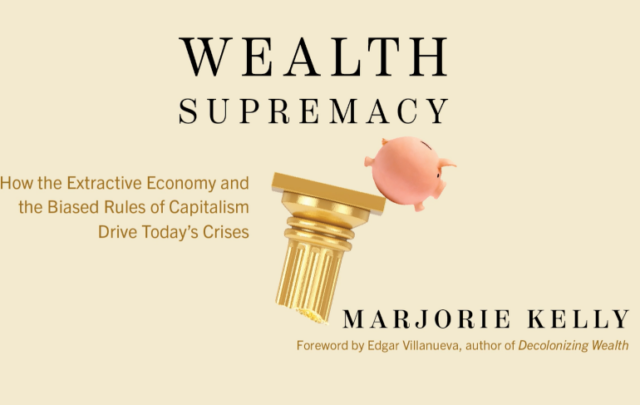Melanie Rieback is the founder of the Post Growth Entrepreneurship (PGE) Incubator, Nonprofit Ventures, as well as her own successful post growth business, Radically Open Security (ROS). We sat down with Melanie to find out more about the innovative program helping founders break free from traditional business models and implement sustainable non-extractive practices.
How do you define Post Growth Entrepreneurship?
I would say it’s entrepreneurship and startup incubation that is focused on building non-extractive and not-for-profit businesses. So we’re trying to use entity forms like foundations and Steward Ownership. We promote cross-subsidizing charity with our businesses, and we’re trying to offer an alternative for startup founders who want to bring their activist, artistic, spiritual business ideas to life without selling out in the commercial startup ecosystem. Too much of the startup ecosystem uses the Silicon Valley model of ‘capital, scale, exit.’ Instead we’re promoting: bootstrapping, flat growth, and non-extraction.
A three-minute Post Growth Entrepreneurship primer
What brought you to post growth thinking and approaches?
When I started my cybersecurity business I knew I wanted it to be a social enterprise. I have philosophical differences with market leaders in the space: they work with intelligence agencies, they hack activists, they build surveillance black boxes that get sold to developing countries; so I wanted to find a way to separate out the profit motive from the actual operational vehicle of a business.
I stumbled on a model from the Dutch church, called a Fiscal Fundraising Institution (FFI), where money is raised via a commercial spin-off and then donated back into the church with tax benefits. So we decided to create an IT security company, and our so-called “church” is the NLnet Foundation, a charity that supports digital rights and open source initiatives. The idea of making it a not-for-profit business just gripped me and didn’t let me go. And it’s become a big success: We’re seven-and-a-half years old now and have served over 150 customers, working on high-profile jobs such as security audits of national COVID-19 contract tracing apps and COVID digital vaccination passports, as well as with organizations like Mozilla and the Wikimedia Foundation. We also work at cost price for nonprofits, NGOs, and civil society. But what’s more interesting is that we donate 90 percent of our profits to charity. In six years, we donated over a half a million Euros, and from 2020 (the pandemic year) we’re going to make another quarter-million Euro donation. We’re showing that you can build a thriving business while giving literally all of your extracted profits to charity.
Somewhere during my entrepreneurial journey, I encountered the work of Kate Raworth, who’s like a ‘gateway drug’ into new economics. Then I found Tim Jackson and the Post Growth Institute, and that gave me a context — I was able to take what I was doing by intuition and put it into a larger framework. So about 3.5 years ago I decided I wanted to write down the lessons I’ve learned from running a business this way, because some of what I’m doing is different from the way other people run businesses. I also wanted to create an incubator to try and help people create similar businesses to ROS, using nonprofit entity structures and that possibly cross-subsidise charity but are otherwise non-extractive.
In general we are over-focused on building new technologies, and trying to create technological band-aids to put over business problems. And as a security/privacy professional, I got really tired of creating yet another Privacy Enhancing Technology (PET) to protect us from Facebook, from Google, from Amazon. It’s not enough. At a certain point I decided I wanted to go after the real problem, which is the business models. Our data is the new oil, because that is what our business models say that it is. And the only way we can truly address business model problems is with business model solutions.

What’s wrong with traditional business models?
Aside from those I’ve mentioned, another issue is that startups usually get a capital injection from investors, which already puts them in a revenue-losing position. They are spending investors’ money, (not money from customer revenue), so they can grow artificially quickly and look outwardly successful. So it’s kind of like a battery chicken: you’re force-feeding your startup so it can get plump, juicy and attractive until the moment it’s ‘liquidated’ (VC jargon for an exit), which is the moment that the value is pulled out, and you’re left with a dysfunctional carcass of what the company once was. And then there’s the “unicorns”, which are companies with a 1 billion plus US dollar valuation. What a lot of people don’t realize is that 90 percent of unicorns are revenue-losing. IPOs are also rather questionable. You’re taking inherently revenue losing businesses and hyping and pumping them up, and then dumping them onto the public stock market. People will buy the shares due to the “greater fool theory”, that it doesn’t matter what people are buying as long as there’s a greater fool who is willing to pay more for it later. This works in a growth economy, but as soon as the economy stagnates or drops, the last investor is left holding the bag. So it’s basically conducting a “pump and dump” scheme onto the public markets — and I find it questionable why this is even legal.
Another question that people don’t ask frequently enough is: whose money are those revenue-bleeding unicorns spending? In the United States, ~60 percent of investment into Venture Capital funds comes from pension funds. So these revenue bleeding companies are actually spending taxpayer money. Pension funds are in a difficult position right now because of low interest rates. People like you and me someday want to retire, but there’s negative interest and traditionally safe investments like bonds are not worth anything anymore. So the Pension Funds (and Investment Funds) are moving to “riskier asset classes”, which includes Venture Capital. The Venture Capitalists are promising 10x returns or more, but if you look historically at the returns from VC funds over the last 25 years, 85 percent of them failed to even keep pace with the stock market. So literally if you had put your money into an Index Fund, and left it there for 25 years, you would have done better than 85 percent of all VC funds. However, the pension funds are desperate, and they don’t see an alternative. They’re also buying up stocks on the other side of the IPO, speculating out of desperation to try to get the returns that will allow people like you and me to retire. So we’re actually paying the price on both sides for these IPOs.
Is donating profits the main way businesses can become ‘post growth’?/h3>
I don’t believe that cross-subsidizing charity is the only way to be post growth. I think that the key point is to eliminate the financial extraction out of businesses to get rid of the perverse incentivization that prompts an organization to make the wrong decisions. I take inspiration from the Nobel Prize-winning economist Muhammad Yunus, who defined Social Business as “dividend-free companies for solving human problems”. He specifies two kinds of Social Business: the first is where all profits are fully reinvested into the business as a social impact vehicle. The second type of Social Business is the same except that the only permitted form of financial extraction is to charity.
How do you teach Post Growth Entrepreneurship?
It’s not something you can teach as much as guide, because the entrepreneurial journey is a lived experience. I ask people to question the basics with starting a company, such as growth. When you get into your typical startup bootcamp as a brand new founder, one of the first things you see is a slide with an exponential curve. The other thing that defines success is the exit — and if you want to be super successful then you do that several times, because then you’re a serial entrepreneur. We’re also told that investment is necessary, which is not true. The Silicon Valley ecosystem has only existed for roughly 40 years, yet somehow we managed to start businesses before VCs. So we need to start out by questioning those givens. We should also question Big Hairy Audacious Goals (BHAGs) which take the form of arbitrary revenue goals, which are not actually helpful for your business. You focus on rapid expansion at the expense of the quality of your business, of how you’re treating your staff, your customers, the ecosystem, and society at large. If you instead focus on creating an ecosystem in which everybody’s happy, you will grow as a byproduct. In fact, you might even grow faster as a byproduct, because you are creating actual value. But this shouldn’t be the main focus.
Melanie’s guest lecture on Post Growth Entrepreneurship to University of Amsterdam MBA students
What’s your experience been with the first two cohorts of the PGE Incubator?
Each cohort has had about a dozen people, and we’ve been experimenting as we go. In the first cohort, we were trying to figure out who would most benefit from the program. I determined that we can best help people in the early stage of startups when they have not yet gotten funding. So they might be thinking about things like investors or crowdfunding campaigns, but haven’t taken that step yet. Founders get involved with our incubator because they want to learn how to bootstrap — and in the startup ecosystem there’s almost nowhere that focuses on teaching founders how to bootstrap their businesses from customer revenue, without relying on investors. We need to make bootstrapping sexy again.
What does the future look like for Post Growth Entrepreneurship?
I’m hoping to create more success stories, more role models, and more living case studies for business school students to examine. We need a translation step between Post Growth Economic theory and actual entrepreneurship. If someone wants to build a post growth business, we have to be able to say: “Here’s the handbook, here’s the business templates, and here’s the supportive community. Now go forth!” As soon as you can start showing people real companies producing real products and services with personnel and balance sheets that you can open and analyze — that is the moment you’ll win over the sceptics. One example is a curiosity; 10 examples start to look interesting; 100 examples need serious consideration… and with 1000 examples, you’ve got a movement.
Three things you can do right now
- Find out more about Post Growth Entrepreneurship.
- Help promote this article by sharing these posts on Twitter, Facebook, and LinkedIn. Sign up here for email alerts when articles like this are shared on social media.
- Sign up for the next PGE Incubator, which takes place online from January 11th to March 1st, 2022.
Teaser photo credit: Annie Spratt via Unsplash





